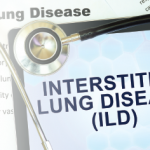Showing several images of lung scans, Dr. Noble walked participants through various images that can help differentiate IPF from NSIP. “It’s all about pattern recognition,” he emphasized, saying that a distinguishing characteristic of IPF is the subpleural honeycombing pattern seen on imaging in which large areas of the lung remain uninvolved.
It is now thought that the pathological process of IPF is different from a disease such as RA. Rather than a systemic disease, IPF is more of a local disease, limited to the lungs.
“We think that IPF is more like a cancer,” he said, with a disease process linked to aging and stem cell failure. He said IPF is nearly unheard of in people younger than 50 years of age and rises dramatically in those 70 years and older. Smoking is also a risk factor.
“We think the disease begins with mutations in alveolar type II stem cells, where inside the cell there are misfolded proteins that are not being handled properly,” he said. Research underway to understand what leads to this process is suggesting that the cells are not regenerating properly, and stem cell failure results in a pathology that is “kind of like a tumor growth underneath the epithelium.”
Saying that 2014 was a watershed year for IPF, he described research aimed at finding ways to stimulate the regenerative process in type II stem cells and halt the growth of fibrosis in lungs that has resulted so far in two new drugs that target this process.
Promising New Treatments
Dr. Noble ended his talk with a review of the clinical trials that led to the approval by the Food and Drug Administration (FDA) of two new drugs to treat IPF.
The first drug, pirfenidone, was approved in 2014, based on results of the CAPACITY trials in 2011 and the more recent ASCEND trial in 2014. The CAPACITY trials were two concurrent randomized trials that assessed the benefit of pirfenidone vs. placebo on lung function in patients with IPF.1 Mixed results were reported in the trials, with one trial showing a positive benefit on lung function with pirfenidone compared with placebo and the second trial showing no difference between the two treatments.1 More recent data from the ASCEND trial showed a significant reduction in disease progression with pirfenidone compared with placebo as reflected by significant improvement in lung function, exercise tolerance and progression-free survival.2
Although no one really knows how it works, it seems to affect a number of inflammatory and fibrotic pathways in the biology of healing, said Dr. Noble. As such, it is thought of as the wound-healing molecule.

